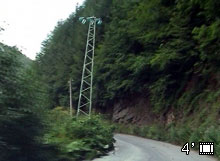|
Afterwards we drive on through Chepelare to Pamporovo arriving, in the late afternoon, at a  residential home for electrical workers that is now part of the EVN concern. M tells us that many communist undertakings had facilities of thiskind which were holiday destinations, assigned by the company, for employees, here in a hiking and skiing area. On the Black Sea coast, he says, there are whole villages like this, one after the other. He’ll point them out when we get there. It’s pretty idyllic here — forest paths, a large pond inhabited by fish, birds at the other side rippling the surface with wading legs, a breeze swishing through the reeds. Except for the two-meter-high chain-link fence to our right, dividing this forest from that. residential home for electrical workers that is now part of the EVN concern. M tells us that many communist undertakings had facilities of thiskind which were holiday destinations, assigned by the company, for employees, here in a hiking and skiing area. On the Black Sea coast, he says, there are whole villages like this, one after the other. He’ll point them out when we get there. It’s pretty idyllic here — forest paths, a large pond inhabited by fish, birds at the other side rippling the surface with wading legs, a breeze swishing through the reeds. Except for the two-meter-high chain-link fence to our right, dividing this forest from that. |
|
A little further on we come upon one bunker-like structure and another blockhouse with a small chimney. There is evidence of age — rust on the fence and overgrown buildings, but also of recent access-denying activity — new chain link overlapping the old, shiny new razor wire added to the top of the fence, a new fuse/meter box added to the outside of the bunker… We are intrigued enough to want to know what is behind the fence. It turns out to be one of the many country estates to which Todor Shivkov—who took over Bulgarian leadership in 1965 and maintained it until the day after the fall of the Berlin wall in 1989—laid claim and is thus a historical as well as geographical boundary. No-one seems to know whether it is still an official residence or whether it has been ‘privatised’. |